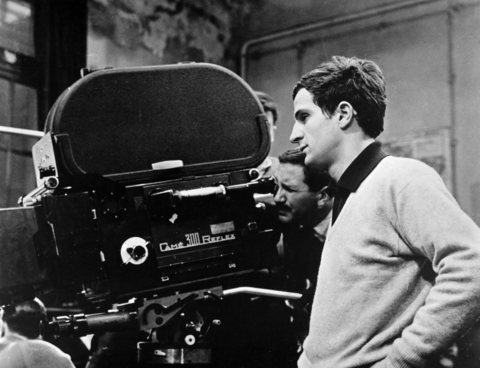From Cineaste, Spring 1993. I must say that I continue to be stupefied that a very respected academic French film critic reviewed this book favorably in Sight and Sound. But I’ve come to value Truffaut far more as a critic than I did in 1993, so I’m delighted that his writing for Arts was recently and belatedly collected in France. My favorite of all his pieces — an early piece about Hitchcock called “Skeleton Keys”– has yet to be collected in either French or English, although Film Culture and the short-lived Cahiers du Cinema in English both ran an English translation back in the 1960s.– J.R.
The historical amnesia currently infecting much of film scholarship, in academic and mainstream publishing alike, is so pervasive that it might be said to affect our sense of the present as well as the past. In theory, then, the most valuable thing about this annotated collection of early film criticism by François Truffaut would be less what it has to tell us about individual films than what it has to impart about film criticism itself in Paris during the Fifties. In practice, however, it proves to be highly problematical on both counts. While I would find a first volume in English of the criticism of Serge Daney, Jean-André Fieschi, Luc Moullet, Claude Ollier, or several other French critics immensely more valuable than a second Truffaut collection (after The Films of My Life, not to mention his collected letters and many other related books in English), additional samplings of his critical work are still certainly welcome. Even a decision to translate his ephemeral early work rather than the sturdier later pieces gathered in Le plaisir des yeux (1987) could be defended if an adequate sense of historical context and scholarship were brought to the task. Regrettably, what this work has received instead is a grotesque imitation and unconscious parody of such work. Mainly demonstrating the potential abuses of the academic apparatus, it could perhaps serve as a guide to cynical graduate students hoping to convey an air of authority without undertaking the necessary research, but as a guide to early Truffaut it winds up confusing a lot more than it clarifies.
Consider the very first review printed in the midst of Wheeler Winston Dixon’s commentary — a five-sentence tossed-off capsule by Truffaut on Tuna Clipper for Cahiers du cinéma receiving six paragraphs of busy exegesis. The capsule devotes its longest sentence to the lead actress’s breasts, termed “promising…no, generous; or, rather, willing,” also “well-behaved,” “friendly,” and “sort of hospitable.” “A mitigating factor in the obvious sexism displayed in this piece might be Truffaut’s forthrightness in declaring his fascination with Elena Verdugo’s chest,” Dixon ventures, though why this “might be” so isn’t spelled out. Because William Beaudine’s direction of Tuna Clipper is deemed “completely creditable, as we would have liked it to be for the same director’s Charlie Chan |sic],” Dixon feels justified in claiming that “Truffaut applies the auteur theory here,” apparently unaware that just about any French critic in 1953 could have made the same unexceptional remark about Beaudine’s direction, and completely ignoring the fact that Truffaut’s very first formulation of “la politique des auteurs” (according to the first volume of Antoine de Baecque’s reliable Les Cahiers du cinéma: Histoire d’un revue), which Truffaut never called a theory in the first place, appeared fourteen months after this capsule was published.
Such elaborate gaffes prove to be all too typical of a graceless text that can refer to Bresson’s second feature as The Ladies of the Bois de Boulogne, designate “Jeanne |sic] Peters” as the costar of Niagara, assert that Billy Wilder attempted in The Seven Year Itch to control Marilyn Monroe “with Langian totality in every scene,” and pass without correction such translated howlers as “The Small World of Don Camillo,” Richard Brooks’s “Deadline,” “seven years of American cinema from The Lady from Shanghai |1948]…to They Live by Night…with Humphrey Bogart as costar,” and “I would ask her…to explain to me in what way South Sea Sinner is badly set.” All these horrors are culled from the first chapter, which also offers the unwarranted and unsubstantiated claim that “a good deal of Godard’s work on the American ‘B’ film has yet to be translated into English.” Translation of this imaginary work would undoubtedly be preferable to the nonstop obfuscation available here.




